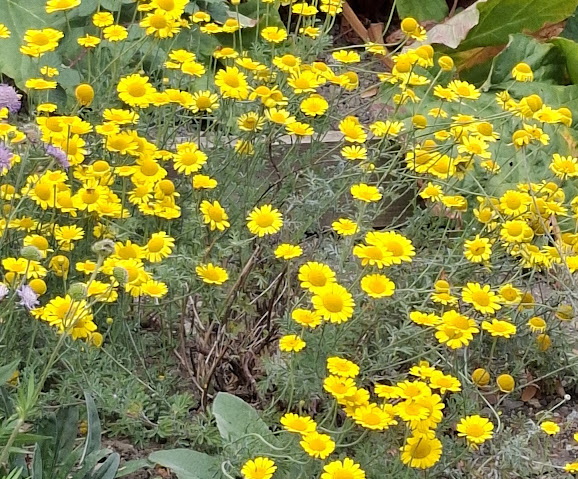Volunteer Contributions at Pontefract Castle
The latest gardening activities in the medieval herb garden at Pontefract Castle have drawn attention to the enthusiastic efforts of the volunteer team. Recently, a newcomer, Lillie, joined the ranks, receiving a warm welcome and an insightful tour of the garden from Carole, one of the veteran volunteers. Lillie familiarized herself with the health and safety guidelines specific to the medieval herb garden before stepping outside to see the plants in their natural settings.
In the midst of this, Carole took the opportunity to trim back some spent flowers, including alecost, marigolds, and chicory, noting that growth this year was ahead of schedule compared to the previous year. Meanwhile, fellow volunteers Helen and Dave focused their efforts on weeding, ensuring the garden remained in great shape.
A highlight of the day was an unexpected visit from members of the Brazilian punk rock band ‘Anti Virus.’ The lead singer, particularly keen on the herbs, engaged with the garden’s offerings and translated plant properties for his bandmates, sharing how they are utilized back in Brazil.
Spotlight on Dyer’s Chamomile
Within the lively atmosphere of the garden, one plant stood out: Dyer’s chamomile (Cota tinctoria). The name “chamomile” derives from the Greek terms ‘chamai,’ meaning ‘on the ground,’ and ‘mēlon,’ meaning ‘apple,’ a nod to the plant’s growth habit and fragrant flowers.
The addition of “dyer’s” refers to its traditional role in the textile industry as a source of yellow dye. In Latin, the term ‘tinctoria’ aligns with the notion of dyeing—the significance of this plant stretches beyond botany and into historical craftsmanship.
Alternately known as yellow chamomile, golden marguerite, and ox-eye chamomile, this plant is still extensively recognized in horticulture by its synonym, Anthemis tinctoria.
| Dyer’s Chamomile in the Garden |
| A vibrant sight in the Medieval Herb Garden. |
Originating from Europe, the Caucasus, and Iran, Dyer’s chamomile flourishes with bright yellow flowers from May to October, boasting an impressive flowering period that lasted 30 weeks in the garden last year. As a clump-forming, evergreen perennial, it maintains its character but may require pruning after blooming to prevent legginess.
This resilient plant thrives in neutral to alkaline, well-drained soils and adapts well to various sunlight conditions, even tolerating maritime exposure. Typically growing to a height of up to 2 feet, it features feathery foliage, dark green above and greyish beneath, carrying a soothing aroma.
Culinary Potential of Dyer’s Chamomile
While Dyer’s chamomile is historically significant for its dyeing properties, it presents no documented culinary uses. It’s essential to distinguish it from German and Roman chamomile, which are commonly utilized in teas.
Dyeing with Dyer’s Chamomile
The flowers of Dyer’s chamomile can be employed fresh or dried to create vibrant dyes. This plant possesses compounds such as flavones and flavonols, which yield various shades of yellow when combined with a mordant, such as aluminum sulfate (alum). This process is key, as a mordant intensifies and fixes the dye to fibers; without it, the resulting color might be weak or non-existent.
Dyer’s chamomile functions effectively on wool and silk, creating beautiful, handcrafted textiles.
Folklore and Ecological Interactions
In addition to its historical significance, Dyer’s chamomile can be blended with yarrow and nettles to craft a nutritious liquid fertilizer, indicating its multifaceted role in sustainable gardening practices. This plant is also a favorite among pollinators, attracting bees, butterflies, and various insects, enhancing biodiversity within the garden.
Historical Uses of Dyer’s Chamomile
In medieval times, this plant found applications in traditional medicine, reputed for its anti-inflammatory and soothing effects. It was commonly brewed into teas made from flowers or the entire plant, applied as poultices for ailments, and even used in bathwater to alleviate discomfort. Precaution was advised, as it could cause skin blisters in sensitive individuals.
Bringing a piece of medieval history to life, Dyer’s chamomile embodies the interwoven narratives of culture, wellness, and environmental consciousness. Embarking on this educational journey can illuminate the rich tapestry of historical gardening practices.
Even the best reviews and the most genuine feedback can’t replace the value of personal experience. With GetExperience.com, booking your adventure means enjoying verified experiences at affordable prices, ensuring you make well-informed decisions without unnecessary expenses. Explore the array of choices that exemplify convenience, affordability, and extensive options available to travelers—whether it’s diving into medieval nature walks or discovering local culture. Reserve a sua viagem hoje mesmo em GetExperience.com.
In summary, Dyer’s chamomile serves not only as a beautiful botanical but also as a cultural artifact, linking history and nature with modern tourism. It represents a fantastic opportunity for anyone interested in adventure activities, eco-friendly practices, and immersive learning experiences—an essential part of today’s travel tapestry.

